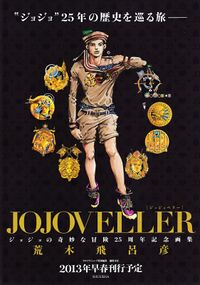JOJOVELLER (September 2013)
Asahi Shimbun (September 2013)
Interview Archive
Interviews with Hirohiko Araki's various editors and assistants. These were published in the History book in JOJOVELLER, released on September 19, 2013.
Interview
Hiroshi Sekiya
Sekiya: Another point is that Araki-sensei said, "I want a woman to be the main protagonist."
Q: This is for Part 5, right? You don't mean Jolyne from Part 6, but Giorno as a woman?
Sekiya: Around the time he brought it up, Giorno’s name hadn’t been decided yet. It’s not an issue these days, but back then my impression was that a female lead in a shonen manga would have been very tough to sell. During that era of Weekly Shonen Jump, it simply wasn’t the time. Thus, during my meeting with sensei, we spoke about this and that, and in the end, the protagonist ended up not being a woman. However, Giorno’s stand has the ability to create life, right? Women give birth to life, so I think this concept was probably left over from the idea of having a female protagonist.
Q: Giorno is an elegant and somewhat androgynous character. Is the initial idea of having him be a woman related to that?
Sekiya: Giorno’s real name, Haruno Shiobana, is also very feminine, right? Sensei may have been thinking of having the story unfold with Giorno being revealed to be a woman. Now that I think about it, he used to joke around with ideas, saying things like: "What about if it was a woman who looked like a man? Wonder if that would work?" (laughs)
Hideto Azuma
Q: Part 6 had the first female protagonist. Was this Araki-sensei’s idea?
Azuma: That’s right. As a shonen magazine editor, I politely asked him to make the protagonist a boy, but he refused in 3 seconds (laughs). The readers of Weekly Shonen Jump wouldn't accept a female lead, which is why I wanted him to change it, but he just replied, "That's exactly why we're doing it".
Looking back at the series' popularity at the time, I still believe that a male protagonist would have been better. However, considering the long history of the JoJo series, I also think that it was overwhelmingly beneficial that the Part 6 lead was female. I get the impression that Araki-sensei is the type of person who won’t repeat the same thing twice. He is the type of artist who constantly takes on new challenges, so maybe he instinctively knew he'd lose the motivation to draw if he chose a male protagonist just for notoriety’s sake.
It was around then that strong female leads had also begun appearing in films, so perhaps he thought the time was right. If he really cared about gaining popularity, he could have just made the protagonist something like a "miniature" version of Jotaro from Part 3. He wouldn't do that though, he's the type of artist who has to continue fighting.
Q: From an editor’s point of view, what type of artist did Araki-sensei seem like at the time?
Azuma: He could construct both the characters and the story firmly in his head and always met deadlines, making him very easy to work with and highly valued by the editorial department. I suppose I was chosen to be Araki-sensei's editor because the higher-ups thought that our hobbies were similar, rather than my suitability as a manga editor. Much like Araki-sensei, I also love music and films, and I know pretty much all of the music that he listens to. I think the editorial department considered it important that Araki-sensei was able to work comfortably. I had the privilege of working for him for two-and-a-half years, but at that point only about 5 of my ideas were used (laughs).
Tomoyuki Shima
Q: Part 7 takes place in a parallel world from the rest of JoJo up to that point. What were Araki-sensei's thoughts on this?
Yamauchi: From his point of view, "it's alright if it's not connected to Part 6, right?" On the topic of Part 6, he also said, "That's just one of the many Stone Oceans." By the end of Part 6, he had told me about his plans for Part 7, but only in vague terms like, "The next part is about the steel ball." So at first I had no idea what he was talking about (laughs).
Satoshi Yamauchi
Q: The Morioh in Part 4 and the Morioh in Part 8 have the same name but are different places. They exist in parallel worlds. But was there any consideration to have Part 8's Morioh be the same as Part 4's?
Yamauchi: As far as I know, there was no such discussion. I remember we talked about having the setting be similar to Part 4's to make readers smile. But I don't think we ever talked about setting the story in the same town. Oh, but we jokingly remarked, "Rohan being there might be fine." After all, he managed to complete his manuscripts on time even during the climax of Part 6, where time was accelerating, so there's a possibility that he exists beyond time and space (laughs).



